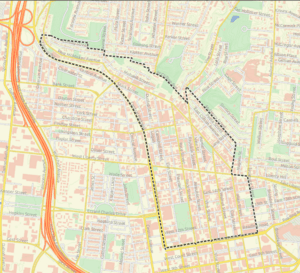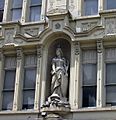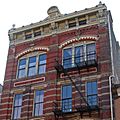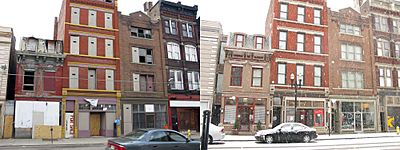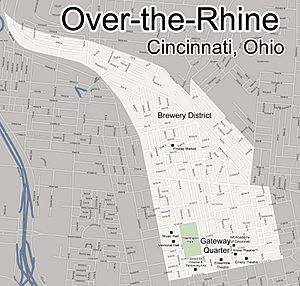Over-the-Rhine facts for kids
Quick facts for kids |
|
|
Over-the-Rhine Historic District
|
|

From upper left: Italianate architecture, the Art Academy of Cincinnati, the OTR Gateway Quarter, Music Hall, Findlay Market, and the School for Creative and Performing Arts
|
|
| Location | Bounded by Central Parkway to the south, Central Parkway to the west, Sycamore St. to the east, and Mulberry, W Clifton & Klotter St. to Brighton Approach to the north.Cincinnati, Ohio |
|---|---|
| Area | 319 acres (1.29 km2) |
| Architectural style | Greek Revival and Late Victorian |
| NRHP reference No. | 83001985 |
| Added to NRHP | May 17, 1983 |
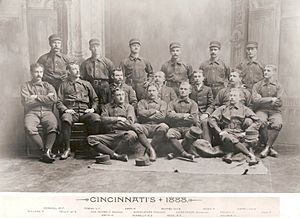
Over-the-Rhine, often called OTR, is a cool neighborhood in Cincinnati, Ohio. It's known for its many old buildings and is one of the biggest historic districts in the United States. Long ago, people from Germany, especially the Rhineland, settled here. Later, people from other backgrounds also made OTR their home. You can find famous places like Music Hall and Findlay Market here.
Contents
What's in a Name?
The name "Over-the-Rhine" comes from the German settlers who moved here in the mid-1800s. They had to cross bridges over the Miami and Erie Canal to get to work downtown. They jokingly called this canal "the Rhine," just like the famous river in Germany. So, the area north of the canal became known as "Over the Rhine." In German, they called it über den Rhein.
One of the first times someone wrote about the canal as "the Rhine" was in an 1853 book. A traveler named Ferenc Pulszky wrote that Germans lived "across the Miami Canal, which is, therefore, here jocosely called the 'Rhine.' " Later, in 1875, a writer named Daniel J. Kenny said that both Germans and Americans loved to call the area "Over the Rhine."
Eventually, the canal was filled in and covered by Central Parkway. A tunnel was built there for a subway project that was never finished.
A Look Back: History of OTR
Over-the-Rhine was built in the 1800s when many German immigrants came to Cincinnati. At first, people from Pennsylvania Dutch country settled here, followed by many more Germans. After World War II, many residents moved to the suburbs. The city also lost many factory jobs. By the end of the 1900s, the area faced challenges. But people in the community worked together to help each other. After some difficulties in 2001, the neighborhood has received a lot of money and effort to make it better.
Exploring Over-the-Rhine's Areas
Over-the-Rhine is one of the largest historic districts in the United States. It has several different parts. The Northern Liberties and the Brewery District are north of Liberty Street. South of Liberty Street, you'll find the Gateway Quarter and Pendleton.
The Gateway Quarter
This part of Over-the-Rhine is sometimes called "The Gateway Quarter." In recent years, this area has seen many changes. New buildings and businesses have moved in, making it a more modern and popular place to live.
The Brewery District
North of Liberty Street was once the center of Cincinnati's beer-making industry. Christian Moerlein started his first brewing company here in 1853. His company, the Christian Moerlein Brewing Co., grew to be the biggest brewery in the city. It even took up three whole city blocks! But then, in the 1920s, a law called Prohibition stopped all alcohol production, and the company closed. Luckily, in 2010, the Christian Moerlein Brewing Co. started brewing beer in the Brewery District again.
North of Liberty Street
This part of the neighborhood still looks a lot like it did in the 1990s. It hasn't changed as much as other areas.
In the late 1820s, a famous English writer named Fanny Trollope lived in the Mohawk area, which is now part of Over-the-Rhine. She wrote a book called Domestic Manners of the Americans, which described Americans of that time.
Until 1849, Liberty Street was the northern edge of Cincinnati. The area north of it was called "The Northern Liberties" because it wasn't under city rules. In 1955, the city made Liberty Street wider to connect with Reading Road. This meant tearing down buildings on the south side of the street. Now, efforts are being made to make Liberty Street narrower again to bring the two halves of the neighborhood closer.
Making OTR Better: Revitalization
Over-the-Rhine Neighborhood Revitalization
Over-the-Rhine faced many challenges in the early 2000s. However, since then, a lot of work has gone into making it a better place. Private companies and city leaders have teamed up to solve problems like low employment and high crime rates. They are working to update and improve the area, often with private companies leading the way.
Cincinnati Center City Development Corporation (3CDC)
The Cincinnati Center City Development Corporation (3CDC) is a private, non-profit group. They work to bring new life to Cincinnati's downtown and Over-the-Rhine areas. Many people say that 3CDC has done a great job in helping OTR improve. They started by developing real estate, but now they also organize over 1,000 events each year in places like Fountain Square and Washington Park.
3CDC was started in 2003 by former Cincinnati mayor Charlie Luken and other community leaders. Most of their money comes from donations from companies. By 2018, they had helped invest over $1.3 billion in projects in downtown and Over-the-Rhine.
Amazing Architecture
Over-the-Rhine is famous for its beautiful old buildings. The New York Times said the neighborhood feels like Greenwich Village in New York. Its buildings have also been compared to the French Quarter in New Orleans and historic areas in Savannah, Georgia and Charleston, South Carolina. When Arthur Frommer, who created the Frommer's travel guides, visited OTR, he said it had the most potential for tourism in the United States. He thought it could "literally rival similar prosperous and heavily visited areas."
Most of OTR's fancy brick buildings were built by German immigrants between 1865 and the 1880s. The buildings show many styles from the late 1800s. These include simple local styles, Greek Revival, Italianate, and Queen Anne. While most buildings fit these styles, you can also find others:
- The Art Deco American Building on Central Parkway.
- The Germania Building at Twelfth and Walnut streets, which is one of the few buildings with German designs.
- Music Hall, which mixes styles, but is best described as Venetian Gothic.
- Some buildings with Gothic architecture.
- The new SCPA on Central Parkway, a great example of Modern architecture.
New Buildings and Designs
Architect Evans Woollen III helped redesign parts of the historic neighborhood in the 1970s and 1980s. He designed the Over-the-Rhine Pilot Center, which included four modern buildings. These buildings had a recreation center, a senior citizens center, a school, and a meeting space.
Saving Old Buildings
In 2011, the Over-the-Rhine Foundation won an award for their work to save historic buildings. In 2006, a group called the National Trust for Historic Preservation said that Over-the-Rhine was "Endangered." Since 1930, about half of OTR's historic buildings have been torn down. More will be lost if old buildings are not fixed.
Between 2001 and 2006, the city had to approve over 50 "emergency demolitions." This happened because some building owners let their properties get so run down that they became dangerous. If money had been invested earlier, these buildings could have been saved. Because of this, Over-the-Rhine was named one of Eleven Most Endangered Historic Places in 2006. A 2008 travel guide even mentioned the district's "shocking state of neglect."
In 2001, some of the worst-kept buildings were owned by non-profit groups in OTR. They couldn't fix the buildings because they didn't have enough money or volunteers. Now, investors and developers are working to restore these old buildings before they fall apart. In 2010, the U.S. Census Bureau found that part of Over-the-Rhine had one of the highest numbers of empty and abandoned homes in the country.
In recent years, many buildings have been restored and new developments have appeared. The focus is on bringing in local small businesses instead of big chains. Old buildings have been fixed up, Washington Park was renovated, and new businesses and people have moved into spaces that were once empty. Local chefs and craft brewers especially love the area. In 2018, Food & Wine Magazine called it "one of the country's most promising food scenes."
People of Over-the-Rhine
| Population of Over-The-Rhine 1819-2020 | ||
|---|---|---|
| Year | Pop. | ±% |
| 1819 | 10,283 | — |
| 1850 | 13,032 | +26.7% |
| 1860 | 19,226 | +47.5% |
| 1870 | 32,726 | +70.2% |
| 1880 | 33,472 | +2.3% |
| 1890 | 31,525 | −5.8% |
| 1900 | 39,500 | +25.3% |
| 1910 | 36,350 | −8.0% |
| 1920 | 30,200 | −16.9% |
| 1930 | 25,771 | −14.7% |
| 1940 | 24,246 | −5.9% |
| 1950 | 31,586 | +30.3% |
| 1960 | 27,577 | −12.7% |
| 1970 | 15,338 | −44.4% |
| 1980 | 10,206 | −33.5% |
| 1990 | 8,303 | −18.6% |
| 2000 | 6,497 | −21.8% |
| 2010 | 6,064 | −6.7% |
| 2020 | 5,622 | −7.3% |
| 2007 population was estimated at 4970 Wards were utilized from 1840-1890 which have slightly different boundaries from census tracts utilized from 1900-40. | ||
| Over-The-Rhine Amount of Dwelling Units 1950-2020 | ||
|---|---|---|
| Year | Pop. | ±% |
| 1950 | 9,933 | — |
| 1960 | 9,275 | −6.6% |
| 1970 | 7,312 | −21.2% |
| 1980 | 6,387 | −12.7% |
| 1990 | 5,212 | −18.4% |
| 2000 | 4,563 | −12.5% |
| 2010 | 4,298 | −5.8% |
| 2020 | 3,845 | −10.5% |
In 2001, there were about 500 empty buildings in Over-the-Rhine, with 2,500 places to live. Of these, 278 were so bad they were unsafe. Also in 2001, only about 3 to 4 percent of homes were owned by the people living in them, compared to 39 percent for the whole city. In 2007, OTR's population was estimated to be 4,970 people.
At the 2000 census, the people living in Over-the-Rhine were mostly African American (76.9%) and White (19.4%). Less than 4% were other races. About 0.6% of the people were Hispanics or Latinos. The neighborhood's residents make up about 1.2% of Cincinnati's total population.
Recently, as the area has been improved, more people with higher incomes have moved in, and more of them are white. By 2018, it was estimated that OTR's population was 34% white and 54% black.
Fun Annual Events
Here are some cool events that happen every year in Over-the-Rhine:
- Bockfest
- Cincinnati Fringe Festival - happens for two weeks after Memorial Day.
- MidPoint Music Festival
- Cincinnati May Festival
- Cincinnati Reds Opening Day Parade - goes from Findlay Market to Fountain Square.
- Nowhere Else Music and Arts Festival
Famous Landmarks
Many of Over-the-Rhine's famous places are related to the arts. They are mostly found in one area near Downtown.
- Art Academy of Cincinnati: Started in 1869, this is a four-year college for art students.
- Cincinnati Music Hall: Built in 1878, this concert hall hosts the Cincinnati Opera, the Cincinnati Symphony Orchestra, the Cincinnati Pops Orchestra, and the Cincinnati May Festival.
- Emery Theatre: This was the first home of the Cincinnati Symphony Orchestra. A famous conductor, Leopold Stokowski, even said its sound was as good as Carnegie Hall. It's currently being fixed up.
- Ensemble Theatre of Cincinnati: This theater has been in Over-the-Rhine since 1988. It shows new plays and plays that are new to the area.
- Findlay Market: This is the oldest public market in Ohio that has been open continuously. It also hosts special events and a farmers' market.
- Know Theatre of Cincinnati: This theater puts on modern plays, including new works. It also produces the yearly Cincinnati Fringe Festival, which is the biggest performing arts festival in Cincinnati.
- Memorial Hall: This is home to the Cincinnati Chamber Orchestra, the MusicNow festival, and the American Classical Music Hall of Fame and Museum.
- School for Creative and Performing Arts: This is the first K-12 school in the United States for students who want to focus on the arts. In 2009, the school was featured in an MTV reality television show called Taking the Stage.
- Washington Park: This is the second oldest park in the city. It was first used as a burial ground for several small churches.
- Cincinnati Ballet
Historic Churches
Over-the-Rhine is also home to many beautiful and historic churches:
- St. Paulus Kirche, 1419 Race Street (the oldest Protestant church in the city).
- German Baptist Church, Walnut and Liberty Streets.
- Old St. Mary's Church, 123 E. Thirteenth Street.
- Philippus United Church of Christ, West Mcmicken and Ohio Avenues.
- St. John the Baptist Church, Green and Bremen Streets.
- Saint Francis Seraph Church, Vine and Liberty Streets.
- St. Paul Church, East 12th and Spring Streets.
- Salem United Church of Christ, 1425 Sycamore Street.
- Nast Trinity United Methodist Church, 1310 Race Street (now called Over-the-Rhine Community Methodist Church since 2015).
- Wesley Chapel, 76 E. McMicken Avenue.
- Prince of Peace Lutheran Church, 1528 Race Street.
- First Lutheran Church, 1208 Race Street.
- St. John's Unitarian Church, 1205 Elm Street.
Famous People From OTR
- Buddy Gray: A community activist.
- Ronald Howes: An American toy inventor who created the Easy-Bake Oven.
- Venus Ramey: The winner of the 1944 Miss America contest.



